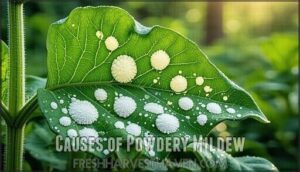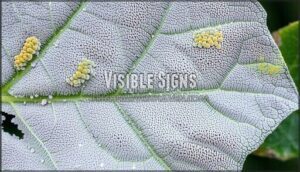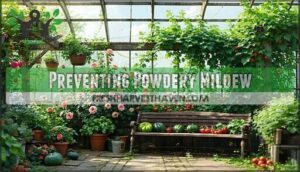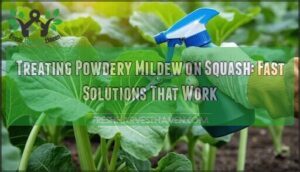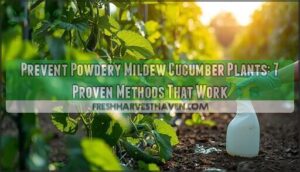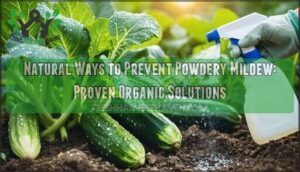This site is supported by our readers. We may earn a commission, at no cost to you, if you purchase through links.
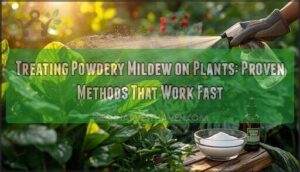
Spray infected plants with a baking soda solution (1 teaspoon per quart of water), apply neem oil weekly, or use commercial fungicides for severe cases.
Remove affected leaves immediately and improve air circulation around your plants.
Milk sprays work too—the proteins create an antifungal environment that fungi hate.
For treating powdery mildew on plants successfully, timing matters most; catch it early when those telltale white patches first appear.
Don’t let humid, stagnant conditions give this stubborn fungus the upper hand in your garden battles, and consider using commercial fungicides for severe cases.
Table Of Contents
- Key Takeaways
- What is Powdery Mildew
- Causes of Powdery Mildew
- Identifying Powdery Mildew
- Treating Infected Plants
- Managing Environmental Conditions
- Preventing Powdery Mildew
- Controlling Powdery Mildew
- Frequently Asked Questions (FAQs)
- How do you treat powdery mildew?
- Does powdery mildew kill plants?
- How do you get rid of powdery mildew on trees?
- Can fungicides treat powdery mildew?
- How do I prevent powdery mildew on my plants?
- Can a garden sprayer treat powdery mildew?
- Can powdery mildew be prevented?
- What is a homemade prevention tactic for powdery mildew?
- How do you get rid of mildew on plants?
- How do you get rid of powdery mildew fast?
- Conclusion
Key Takeaways
- Act fast when you spot white patches – Remove infected leaves immediately and spray with a baking soda solution, neem oil, or milk spray every 7-14 days to stop the spread before it takes over your entire garden.
- Create hostile conditions for the fungus – Improve air circulation by spacing plants properly, prune overcrowded branches, and water at soil level to keep leaves dry, since powdery mildew thrives in humid, stagnant environments.
- Use proven organic treatments that work – Mix 1 teaspoon of baking soda per quart of water, apply neem oil weekly, or use milk spray (1 part milk to 9 parts water) as effective alternatives to harsh chemical fungicides.
- Focus on prevention to avoid future problems – Choose resistant plant varieties, maintain proper spacing for airflow, avoid overhead watering, and monitor plants regularly, since preventing powdery mildew is easier than treating established infections.
What is Powdery Mildew
You’ve likely seen those telltale white, powdery patches spreading across your plant leaves – that’s powdery mildew, a common fungal disease that affects hundreds of plant species worldwide.
This persistent fungus thrives in warm, humid conditions and can quickly spread from plant to plant through airborne spores, causing leaves to yellow, wither, and eventually drop if left untreated.
Symptoms and Signs
You’ll notice powdery mildew starts as small whitegray powder spots on leaf surfaces, quickly spreading into larger patches.
Early mildew signs include leaf discoloration, yellowing, and distorted foliage that looks twisted or curled.
The telltale mildew on leaves creates a dusty coating that rubs off easily.
Plant symptoms worsen rapidly, causing growth stunting and premature drop of infected leaves, weakening your plant’s overall health.
Types of Powdery Mildew
You’ll encounter over 900 species of this fungal disease, each targeting specific plants through host specificity.
Fungal taxonomy reveals distinct genera like Erysiphe, Podosphaera, and Sphaerotheca that create the white powdery mildew patches on your plants.
Genetic variation drives mildew evolution, while resistance mechanisms help certain varieties fight back against spores spreading this plant disease.
Affected Plant Species
Powdery mildew targets specific plant families with ruthless precision.
You’ll find cucurbit susceptibility highest in squash and cucumbers, while rose infections plague your favorite blooms.
Nightshade prevalence affects tomatoes and peppers, and grape vulnerability threatens vineyards.
Lilacs, roses, and legumes also fall victim to this fungal menace.
Causes of Powdery Mildew
Understanding what triggers powdery mildew helps you prevent it from taking hold in your garden.
This fungal disease thrives when specific environmental conditions, plant stress factors, and spore dispersal methods align to create the perfect storm for infection.
Environmental Conditions
Certain environmental conditions create a perfect storm for powdery mildew development.
Temperature ranges between 70-80°F combined with high humidity levels encourage rapid fungal growth. Poor air circulation traps moisture around leaves, while shade restricts sunlight exposure that naturally inhibits spores.
Plant density affects airflow, and improper watering practices increase soil moisture, creating ideal breeding conditions for this persistent fungus.
Understanding natural prevention methods is essential to control the spread of powdery mildew and implement natural prevention to ensure a healthy environment, which is crucial for persistent fungus control.
Plant Stressors
Your garden’s stressed plants become sitting ducks for powdery mildew invasion.
Drought impact weakens plant defenses, while poor soil quality creates nutrient deficiency that compromises immunity.
Inadequate water management—either drought or overwatering—triggers plant stress responses, and high heat compounds these problems.
Improper pruning techniques create entry points, and addressing these stressors before fungal problems take hold is crucial for maintaining plant health and preventing the invasion of fungal problems.
Fungal Spores
Microscopic fungal spores act as powdery mildew’s primary weapon for invasion and survival.
These invisible invaders silently drift through your garden, seeking their next victim to colonize.
These airborne particles drift through your garden on wind currents, landing on susceptible plant surfaces where spore formation begins immediately.
Host specificity means each fungal species targets particular plants—you won’t see rose mildew jumping to your tomatoes.
Understanding fungal biology helps you choose effective powdery mildew treatment and natural mildew remedy options for targeted fungicide application.
Identifying Powdery Mildew
Early detection is essential for stopping powdery mildew before it spreads throughout your entire garden.
You’ll spot this fungal infection as white or gray powdery patches that typically start on leaf undersides, then quickly spread to stems, buds, and even fruit surfaces.
Visible Signs
White spots appearing on your plants aren’t just unsightly—they’re the calling card of powdery mildew.
Here’s what to watch for:
- White or gray patches coating leaf surfaces like flour
- Fuzzy fungal growth spreading across stems and buds
- Chalky residue that easily rubs off with your finger
- Yellow leaf symptoms developing underneath the white coating
These visible signs of mildew start small but quickly spread, making early mildew identification essential for effective powdery mildew treatment.
Infected Plant Parts
Powdery mildew’s reach extends beyond infected leaves to encompass your plant’s entire structure.
You’ll spot the telltale white coating on diseased stems, affected buds, and even fruit surfaces.
This fungal invasion doesn’t discriminate—it attacks tender new growth first, then spreads to mature foliage.
Plant debris harboring fungal spores becomes a breeding ground for reinfection, making thorough cleanup essential for effective powdery mildew treatment.
Spore Dispersal
Unlike many plant diseases that need moisture to spread, powdery mildew spores travel through dry air currents with remarkable efficiency.
Wind Transmission carries these Airborne Pathogens across gardens and between neighboring properties, making containment challenging.
Spore Release occurs when infected leaves are disturbed by breezes or gardening activities.
Water Dispersal happens through irrigation splashing, while insects unknowingly transport spores on their bodies, accelerating Fungal Spread throughout your landscape, which can lead to complete concepts of disease management.
Treating Infected Plants
When powdery mildew strikes your plants, you’ll need to act quickly with the right treatments to stop the fungal infection from spreading.
The good news is that several proven remedies can effectively control this common garden problem and restore your plants to health.
Organic Fungicides
Organic fungicides offer powerful powdery mildew treatment without harsh chemicals.
Neem oil reduces infections by 65-75% in field tests, while sulfur formulations remain the top choice for organic mildew control.
Potassium bicarbonate provides rapid knockdown of visible symptoms, and these natural fungicides require weekly reapplication but effectively suppress spore formation and protect your plants safely.
Effective fungus control methods are essential for maintaining healthy plants and preventing the spread of disease.
Milk and Bicarbonate Soda Treatments
Kitchen staples become powerful allies against fungal infections when you know how to use them properly. These organic solutions offer effective fungal control without harsh chemicals.
- Milk Spray: Mix 1 part milk with 9 parts water for a natural bicarbonate remedy that disrupts fungal cell membranes
- Bicarbonate Soda Treatment: Dissolve 1 tablespoon per gallon of water to alter leaf surface pH
The use of milk as a milk fungicide agent is a key concept in preventing the spread of fungal infections.
Weekly Applications: Apply these organic mildew control solutions every 7 days for maximum powdery mildew treatment effectiveness
Neem Oil and Garlic Remedies
Neem Oil Benefits make this organic fungicide your secret weapon against stubborn infections.
Mix 2 teaspoons neem oil with 1 teaspoon soap per quart of water, while garlic solution combines crushed cloves with water for potent antifungal action.
For effective treatment, understanding neem oil properties is vital for achieving the best results.
| Treatment | Application Rate | Effectiveness Timeline |
|---|---|---|
| Neem Oil Spray | 2 tsp per quart water | 7-10 days visible reduction |
| Garlic Solution | 4 cloves per gallon | 5-7 days symptom suppression |
| Combined Treatment | Alternate weekly | Maximum prevention power |
| Maintenance Dose | Every 14 days | Long-term mildew control |
| Emergency Treatment | Daily for 3 days | Rapid infection halt |
Managing Environmental Conditions
You can control powdery mildew by adjusting the conditions that help it thrive, making your garden less hospitable to this stubborn fungus.
Creating the right environment isn’t just about treating existing infections—it’s about stopping new ones before they start.
Optimal Temperature and Humidity
Understanding the right temperature and humidity for powdery mildew treatment makes all the difference in your battle plan.
The fungus thrives in specific conditions, so targeting these environmental factors becomes your secret weapon.
- Temperature Control: Keep temperatures between 60-80°F where fungus flourishes, but push above 90°F to inhibit growth
- Humidity Levels: Maintain low daytime humidity while managing high nighttime moisture that feeds the problem
- Climate Management: Monitor thermal regulation to create unfavorable conditions for spore development and spread
Effective gardening also involves using natural pest methods to promote healthy plant growth.
Reducing Humidity and Increasing Sunlight
Good air circulation acts as your first line of defense against powdery mildew treatment success.
Position plants where morning sunlight exposure can quickly dry moisture from leaves, while ventilation systems or strategic spacing promotes airflow.
Reducing humidity around foliage prevents spore germination, making humidity control essential for mildew prevention and effective plant disease control in your garden.
Effective heat stress management also plays a vital role in preventing the spread of powdery mildew by maintaining a healthy environment for plants to thrive, which is crucial for overall plant disease control.
Avoiding Overcrowding and Overwatering
Crowded plants become breeding grounds for powdery mildew since poor air circulation traps humidity around leaves.
Space plants properly to guarantee airflow benefits reach every surface.
Monitor your watering frequency carefully—soggy soil creates stress that weakens root health and invites fungal problems.
Check soil drainage regularly, as waterlogged conditions promote the perfect storm for infection.
Preventing Powdery Mildew
You’ll want to stop powdery mildew before it starts rather than fighting it after infection spreads throughout your garden.
Prevention through smart plant selection, proper gardening techniques, and adequate air circulation can save you weeks of treatment and protect your harvest from significant damage.
Resistant Plant Varieties
When selecting mildew resistant plants, you’re investing in your garden’s long-term health. Genetic resistance through modern breeding techniques offers superior disease tolerance compared to susceptible varieties.
- Choose resistant cultivars – Look for varieties with proven powdery mildew resistance in catalogs
- Select disease-tolerant grafting options – Rootstocks can provide additional plant resistance benefits
- Research variety selection – Different strains target specific plants, so match resistance accordingly
- Consider local breeding programs – Regional cultivars often show better adaptation and tolerance
- Stack multiple resistance genes – Plants with combined genetic resistance offer longer-lasting protection
Good Gardening Practices
Beyond choosing resistant varieties, smart gardening habits create an environment where powdery mildew struggles to take hold. Soil Health starts with proper drainage and balanced nutrients—waterlogged roots weaken plants’ natural defenses. Proper Watering at soil level prevents wet foliage that fungi love.
Pruning Techniques remove overcrowded branches, while Mulching Benefits include moisture regulation. Companion Planting with aromatic herbs naturally deters fungal spores.
| Practice | Powdery Mildew Prevention Impact |
|---|---|
| Morning watering | Leaves dry quickly, reducing fungal growth |
| Strategic pruning | Improves airflow, eliminates infected tissue |
| Organic mulching | Maintains consistent soil moisture, prevents stress |
These organic gardening practices for plant disease prevention and garden health maintenance work together as your first line of defense against mildew control methods.
Improving Air Circulation
Stagnant air creates the perfect breeding ground for fungal spores to settle and multiply on your plants.
Poor air circulation traps moisture around leaves, making powdery mildew treatment more challenging and allowing the disease to spread rapidly through your garden.
Here’s how to boost air movement and strengthen your mildew control methods:
- Strategic pruning techniques – Thin overcrowded branches and remove lower leaves to create natural ventilation pathways through your plants
- Smart space management – Plant with adequate spacing between specimens to prevent air pockets and improve overall plant health
- Ventilation systems installation – Position oscillating fans near susceptible plants during humid periods for consistent airflow
- Fan installation timing – Run fans during early morning hours when humidity peaks to accelerate moisture evaporation from leaf surfaces
Controlling Powdery Mildew
Once you’ve identified powdery mildew on your plants, you’ll need to act quickly to prevent it from spreading throughout your garden.
Effective control combines immediate removal of infected parts with regular fungicide applications and ongoing plant health management.
Regular Monitoring and Inspection
Plant Checks are your best friend—don’t wait for mildew on leaves to show up before acting.
Use Inspection Tools to spot early mildew signs and track disease progress.
Fungal Detection means catching plant disease symptoms before they spread. Think of it as Early Warning for powdery mildew treatment.
Master mildew identification tips to keep your garden healthy.
Removing Infected Foliage
Cut away infected leaves at the first sign of mildew on leaves, using clean pruning shears sterilized with rubbing alcohol between cuts.
These sanitation methods prevent spreading spores to healthy foliage. Dispose of debris in trash, never compost infected material.
Proper fungal removal through strategic plant pruning techniques creates better air circulation while eliminating the disease’s foothold in your garden.
Regular use of high-quality pruning shears tools is essential for effective plant maintenance and to prevent the spread of disease.
Applying Fungicides Regularly
Success with fungicides depends on smart scheduling and product rotation.
Apply every 7-10 days when symptoms first appear—waiting reduces effectiveness by 40%.
Rotate between systemic and contact fungicides to prevent resistance buildup.
Myclobutanil achieves 90% control, while organic options like potassium bicarbonate offer safer alternatives.
Morning application enhances absorption without leaf burn risks.
Promoting Healthy Plant Growth and Resistance
Beyond regular fungicide applications, you’ll want to focus on promoting healthy plant growth and resistance through proper plant nutrition and soil quality improvements.
Strong plants naturally resist powdery mildew solutions better than stressed ones.
- Feed your plants balanced fertilizer – well-nourished plants develop stronger immune systems
- Improve soil drainage and aeration – healthy roots support robust above-ground growth
- Rotate crops annually – breaks disease cycles while maintaining soil health
Water management and biological controls work together with good plant disease management practices to create an environment where mildew prevention becomes second nature.
Frequently Asked Questions (FAQs)
How do you treat powdery mildew?
Fungicides reduce powdery mildew symptoms by up to 80% with repeated applications.
Remove infected leaves immediately, then spray with neem oil, potassium bicarbonate, or homemade milk solutions every 7-14 days until you’ve controlled the outbreak.
Does powdery mildew kill plants?
Powdery mildew rarely kills plants outright. While it weakens them by stealing nutrients and hindering photosynthesis, causing yellowing leaves and reduced growth, most plants survive the infection with proper treatment.
How do you get rid of powdery mildew on trees?
Seeing white patches on your tree’s leaves?
Remove infected foliage with clean pruners, then spray fungicide containing neem oil, potassium bicarbonate, or sulfur every seven to fourteen days until symptoms clear.
Can fungicides treat powdery mildew?
Yes, fungicides effectively treat powdery mildew. You’ll need products containing potassium bicarbonate, neem oil, sulfur, or copper. Apply every 7-14 days for best results, following label directions carefully.
How do I prevent powdery mildew on my plants?
Prevention beats cure regarding powdery mildew! Choose resistant plant varieties, make certain proper spacing for air circulation, avoid overhead watering, and maintain consistent soil moisture while keeping foliage dry.
Can a garden sprayer treat powdery mildew?
Garden sprayers work great for treating powdery mildew! You’ll apply fungicides like neem oil or baking soda solutions evenly across affected leaves, reaching spots you’d miss by hand.
Can powdery mildew be prevented?
You can absolutely prevent powdery mildew through smart gardening practices.
Choose resistant plant varieties, make certain of proper spacing for air circulation, water at soil level, and avoid over-fertilizing with nitrogen.
What is a homemade prevention tactic for powdery mildew?
Like an ounce of prevention worth a pound of cure, you’ll find milk spray works wonders.
Mix one part milk with nine parts water, then spray weekly on healthy plants to create a protective barrier against fungal spores.
How do you get rid of mildew on plants?
Remove infected leaves with clean pruning shears, then spray remaining foliage with fungicides like neem oil, potassium bicarbonate, or homemade baking soda solution every seven days.
How do you get rid of powdery mildew fast?
Lightning-fast action beats slow suffering!
Immediately prune infected leaves, spray with baking soda solution (1 tablespoon per gallon), apply neem oil, and make certain proper air circulation.
Repeat treatments weekly until defeated, ensuring that the infection is fully defeated.
Conclusion
Success demands vigilance, while neglect invites disaster.
You’ve now armed yourself with proven strategies for treating powdery mildew on plants, from baking soda sprays to neem oil applications.
Remember that early detection makes all the difference—those first white patches are your cue to act immediately.
Combine multiple treatments for stubborn infections, maintain proper air circulation, and don’t forget preventive measures.
With consistent monitoring and these effective methods, you’ll keep your garden healthy and powdery mildew-free year-round.

